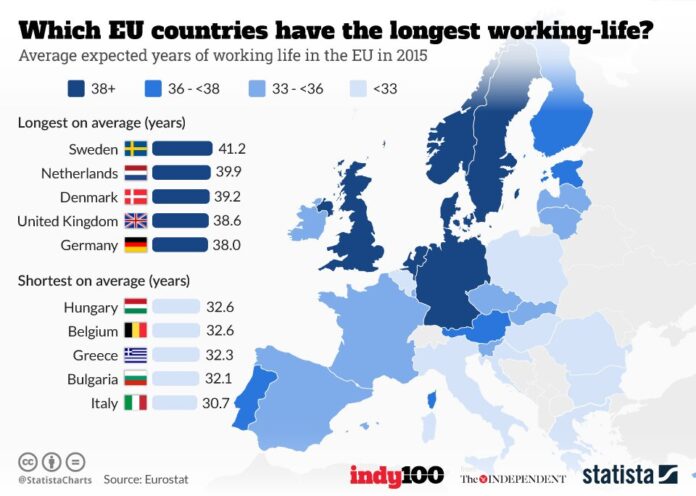We are familiar with the minimum and maximum ages longest working lives in Europe, which is another way to describe the workforce of a nation. Do you know why a concept like retirement is introduced in countries? Let us answer that question for your ‘now’ curious mind. Retirement is something we call after passing an age limit, after which you are asked to relax from your responsibilities. In short, you become ineligible to work anymore because your age doesn’t allow you to work due to several factors. Every country has its own set of workforce age limits, according to its facilities and life expectancy.
However, here is a massive change in the European Union that will give your brain cells a shock. Due to many contributing factors, the life expectancy rate in the EU has been rising in the countries. An increasing life expectancy means that elderly people can work more than the prescribed age limit. Therefore, in the last decade, the workforce age limits have been revised several times already. According to Eurostat’s 2024 database, the average working life of European people was 37.2 years. This is something worth noting, as in 2014, the average working life of an adult was 34.8 years. Additionally, countries have their own life expectancy rates too, such as 32.7 years in Romania and 43.8 years in the Netherlands.
How long are working lives across Europe?
The above statistics are estimated life expectancy rates of all European countries combined in a single figure. However, if we determine this figure for individual life expectancy rates of the countries, we will see the difference. Throughout Europe, life expectancy varies according to the country and its geographical location. The data and patterns over the years are enough to tell that Northern European countries have a higher life expectancy. In the Nordic regions of these countries, such as Iceland, the Netherlands, and Sweden, people are forever at work.
People are capable of working for 43.8 years in the Netherlands and 43 years in Sweden, which is among the longest working experiences. In the list of top countries with a high life expectancy rate, Denmark, Norway, and Finland have also made their mark. A 42.5-year expectancy in Denmark, 41.2 years in Norway, and 39.8 years in Finland, making them enter the top 10 list. Iceland tops them all with a life expectancy rate of 46.3 years, which means the workforce works for more than half of their lives.
Apart from Northern European countries, Western countries are also not so far behind in the figures. Switzerland, Ireland, and Germany are the countries that are categorised in the 40 and above life expectancy category. The rest of the countries are almost equal or closer to the estimated average life expectancy in the EU. Similarly, in Southern and Eastern European countries, the life expectancy rate is closer to the EU average determined by analysts.
Why are there differences in the Life Expectancy rates across European countries?
After reading all these statistical terms in this article, didn’t a ‘why’ question strike your mind? How is geographical location responsible for such varied terms of the Life Expectancy rate? What controls the variation of this index in the European economy? All the answers are available in this section of the article, for which you need to read it in full.
There are many factors that affect the stability of the Life Expectancy rate in a country. The first one is that the demand in an economy plays an important role in indirectly destabilising life expectancy. It can be that due to excess demand, more workers are hired or the existing ones have to work overtime. The second factor is that pension and labour market regulations also go hand-in-hand with the determination of this index. Therefore, if the system does not provide many offers at early retirement, people usually work for an easier life ahead.
The last reason why countries might have a higher life expectancy rate is their non-discriminatory behaviour toward ageing. When you are supportive of elders, irrespective of their age, they will want to contribute more to the economy. It is not a physical factor, but a psychological one, which determines their productivity. At last, all these factors combined shape life expectancy and the contribution of the elderly to the economy.
Why is labour force participation essential in an economy?
According to Eurostat, there is a direct relationship between the labour force participation and the life expectancy rate. This means that if a country has a lower labour participation in any sector of the economy, its life expectancy falls. Moreover, if we feed the data provided by Eurostat into a scatter plot, we can understand the correlation between them. The results will show the kind of relationship the total population, labour force participation rate, and life expectancy rate possess.
On calculating, the labour force participation rate is reading 81.5% of the variations in the life expectancy rate. The higher the variability of a model, the higher its compatibility with the variables, in this case, labour force participation. Therefore, at such a rapid rate of increase in life expectancy, this index might even exceed 70 years. Additionally, countries are trying to implement some measures to increase the retirement age and the productivity of the workforce.
Conclusion
We are mostly focused on the figures shown to us after extraction from a bigger database, hiding many other insights. Therefore, to understand the working of the economic system of a country, one must pay attention to the indices. They reveal a part of the economy that analysts or their upper-hand data might never reveal. Life expectancy is an important indicator of an economy’s productivity and social values and morals.








